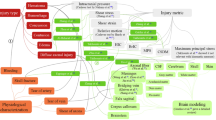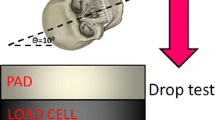Abstract
The formation of skull fractures is an important topic in legal medicine. In particular, the influence of boundary conditions is controversially discussed in the literature. A study focusing solely on this aspect was missing. This study aimed to investigate the influence of boundary conditions on the energy threshold for head fractures. Because of the great variability of biological tissue of real skulls, we opted for a head model made from a polyurethane sphere filled with gelatin. Furthermore, we decided to investigate two opposite situations: A fixed configuration where a model was placed on a rigid surface and a (quasi) free boundary configuration where the head model was held at a force of 5 N compensating for gravity. For both configurations, we determined the acceleration signal of the impactor, the force, and the energy threshold for head fracture. It turned out that the fracture forces for both configurations were the same whereas the energy threshold was 11.0 J for the fixed and 13.6 J for the free boundary. The difference seems to be negligible if compared to the effect of varying structural mechanical properties of real human heads. This means that in a forensic case, the two situations most probably cannot be distinguished. To investigate the influence of the impactor mass, we developed a mathematical model and fitted the experimental data. As a result, we found that in the free configuration, a larger mass increases the energy threshold for head fracture. So that in principle, the two configurations are distinguishable.











Similar content being viewed by others
Notes
In comparison to real long bones (e.g., hemurus) Frankenberg et al. [18] found a lower fracture force for polyurethane cylinders.
References
Park J, Son H (2017) Weapon use in Korean homicide: differences between homicides involving sharp and blunt instruments. J Forensic Sci 63:1134–1137. https://doi.org/10.1111/1556-4029.13673
Ambade VN, Godbole HV (2006) Comparison of wound patterns in homicide by sharp and blunt force. Forensic Sci Int 156(2–3):166–170. https://doi.org/10.1016/j.forsciint.2004.12.027
Stiell IG, Wells GA, Vandemheen K, Clement C, Lesiuk H, Laupacis A, McKnight RD, Verbeek R, Brison R, Cass D, Eisenhauer ME, Greenberg G, Worthington J (2001) The Canadian CT head rule for patients with minor head injury. Lancet 357(9266):1391–1396
Yoganandan N, Zhang J, Pintar F (2004) Force and acceleration corridors from lateral head impact. Traffic Inj Prev 5(4):368–373. https://doi.org/10.1080/15389580490510336
Verschueren P, Delye H, Depreitere B, Van Lierde C, Haex B, Berckmans D, Verpoest I, Goffin J, Vander Sloten J, Van der Perre G (2007) A new test set-up for skull fracture characterisation. J Biomech 40(15):3389–3396. https://doi.org/10.1016/j.jbiomech.2007.05.018
Delye H, Verschueren P, Depreitere B, Verpoest I, Berckmans D, Vander Sloten J, Van Der Perre G, Goffin J (2007) Biomechanics of frontal skull fracture. J Neurotrauma 24(10):1576–1586. https://doi.org/10.1089/neu.2007.0283
Mole CG, Heyns M, Cloete T (2015) How hard is hard enough? An investigation of the force associated with lateral blunt force trauma to the porcine cranium. Legal Med 17(1):1–8. https://doi.org/10.1016/j.legalmed.2014.07.008
Viano DC, Bir C, Walilko T, Sherman D (2004) Ballistic impact to the forehead, zygoma, and mandible: comparison of human and frangible dummy face biomechanics. J Trauma 56(6):1305–1311
Kroman A, Kress T, Porta D (2011) Fracture propagation in the human cranium: a re-testing of popular theories. Clin Anat 24(3):309–318. https://doi.org/10.1002/ca.21129
Schneider D, Nahum A (1972)Impact Studies of Facial Bones and Skull. In: 16th Stapp Car Crash Conference, 1972/02/01/ 1972. https://doi.org/10.4271/720965
Nahum AM, Gatts JD, Gadd CW, Danforth J (1968) Impact Tolerance of the Skull and Face. 12th Stapp Car Crash Conference Proceedings. SAE No. 680785, No. 680785 edn. SAE International, Warrendale, PA. https://doi.org/10.4271/680785
Ruan JS, Khalil T, King AI (1991) Human head dynamic response to side impact by finite element modeling. J Biomech Eng 113(3):276–283
Ruan JS, Khalil T, King AI (1994) Dynamic response of the human head to impact by three-dimensional finite element analysis. J Biomech Eng 116(1):44–50
Raymond D, Van Ee C, Crawford G, Bir C (2009) Tolerance of the skull to blunt ballistic temporo-parietal impact. J Biomech 42(15):2479–2485. https://doi.org/10.1016/j.jbiomech.2009.07.018
Thali MJ, Kneubuehl BP, Dirnhofer R (2002) A “skin–skull–brain model” for the biomechanical reconstruction of blunt forces to the human head. Forensic Sci Int 125(2):195–200. https://doi.org/10.1016/S0379-0738(01)00639-9
Thali MJ, Kneubuehl BP, Zollinger U, Dirnhofer R (2002) The “skin–skull–brain model”: a new instrument for the study of gunshot effects. Forensic Sci Int 125(2):178–189. https://doi.org/10.1016/S0379-0738(01)00637-5
Kneubuehl BP, Coupland R, Rothschild M (2011) Wound Ballistics: Basics and Applications, 1st edn. Springer-Verlag Berlin Heidelberg, Berlin Heidelberg. https://doi.org/10.1007/978-3-642-20356-5
Franckenberg S, Nyffeler RW, Siegenthaler L, Kneubuehl BP, Bolliger SA, Thali MJ, Ross SG, Vonlanthen B (2013) Three cases of humeral shaft fracture during police arrest —biomechanical aspects and reconstruction of events. J Forensic Radiol Imaging 1(3):112–118. https://doi.org/10.1016/j.jofri.2013.05.006
Smith MJ, James S, Pover T, Ball N, Barnetson V, Foster B, Guy C, Rickman J, Walton V (2015) Fantastic plastic? Experimental evaluation of polyurethane bone substitutes as proxies for human bone in trauma simulations. Leg Med (Tokyo) 17(5):427–435. https://doi.org/10.1016/j.legalmed.2015.06.007
Raymond DE, Bir CA (2015) A biomechanical evaluation of skull-brain surrogates to blunt high-rate impacts to postmortem human subjects. J Forensic Sci 60(2):370–373. https://doi.org/10.1111/1556-4029.12693
Cronin DS, Falzon C (2011) Characterization of 10% ballistic gelatin to evaluate temperature, aging and strain rate effects. Exp Mech 51(7):1197–1206. https://doi.org/10.1007/s11340-010-9438-z
Sprenger FD, Siegenthaler L, Kneubuehl BP, Jackowski C (2015) The influence of striking object characteristics on the impact energy. Int J Legal Med 130:835–844. https://doi.org/10.1007/s00414-015-1268-1
Siegenthaler L, Sprenger FD, Kneubuehl BP, Jackowski C (2018) Impact energy of everyday items used for assault. Int J Legal Med 132(1):211–217. https://doi.org/10.1007/s00414-017-1689-0
Author information
Authors and Affiliations
Corresponding author
Ethics declarations
Conflict of interest
The authors declare that they have no conflict of interest.
Additional information
Publisher’s note
Springer Nature remains neutral with regard to jurisdictional claims in published maps and institutional affiliations.
Rights and permissions
About this article
Cite this article
Siegenthaler, L., Strehl, M., Vaghi, A. et al. Threshold of the skull injury for blunt force impacts under free and constraint boundary conditions. Int J Legal Med 134, 553–563 (2020). https://doi.org/10.1007/s00414-019-02023-2
Received:
Accepted:
Published:
Issue Date:
DOI: https://doi.org/10.1007/s00414-019-02023-2




